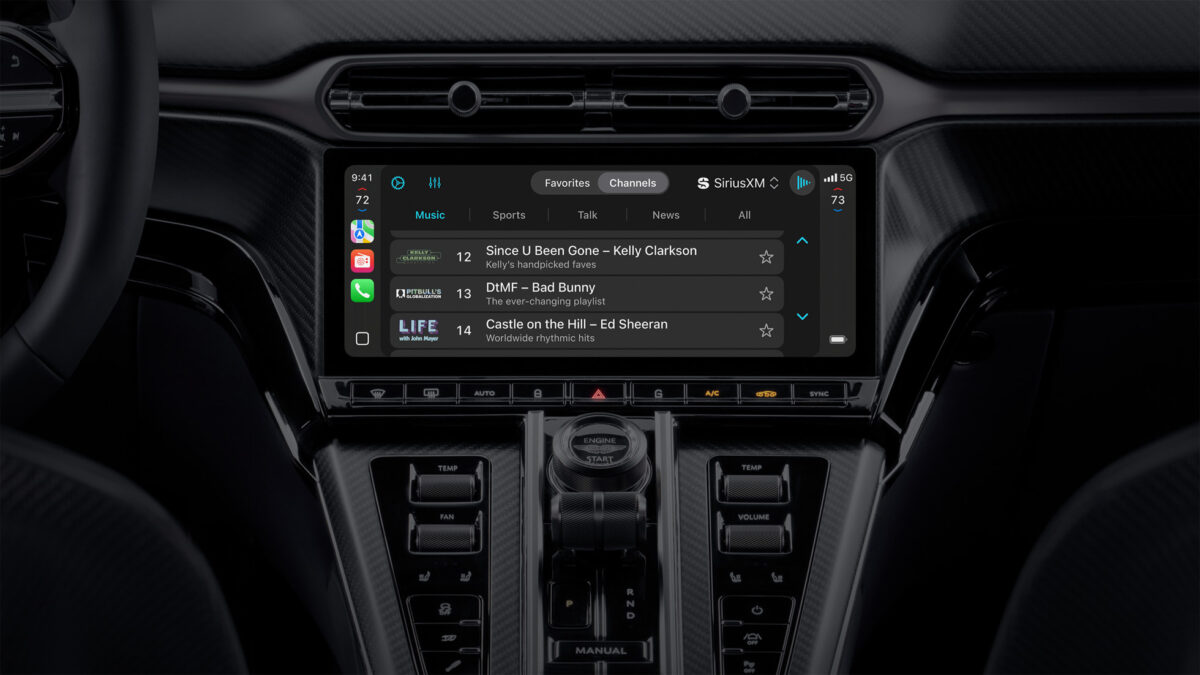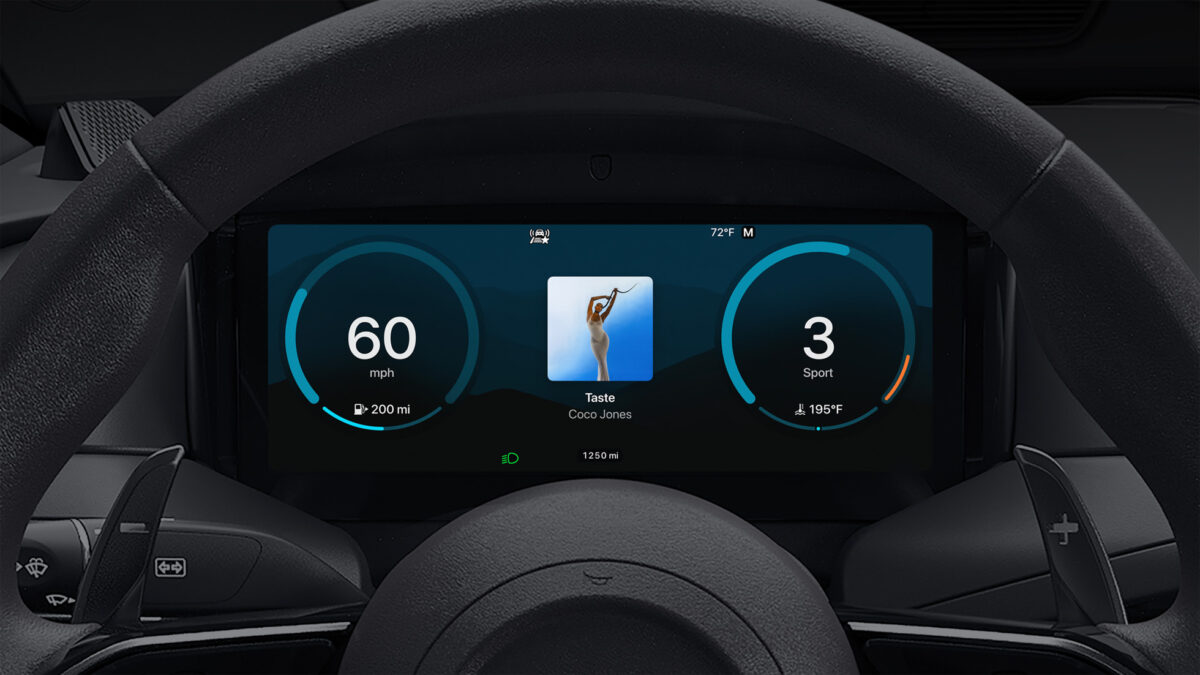Apple’s New CarPlay Ultra – What’s so Ultra about it?

CarPlay Ultra interior center console
Apple’s long-teased “next-gen” CarPlay, now officially called CarPlay Ultra, is beginning to roll out — starting with high end manufacturer, Aston Martin. While it doesn’t reinvent in-car tech entirely, it marks a significant shift in how Apple wants your iPhone to become the central brain of your vehicle.
Unlike the older version of CarPlay, which essentially mirrored your iPhone’s apps onto one screen, CarPlay Ultra now extends across all driver-facing displays — including the instrument cluster — and integrates with the vehicle’s own data and systems. This includes fuel level, speed, climate control, and even audio settings.
More Than Mirroring: Technical Architecture
At its core, CarPlay Ultra merges content rendered by the iPhone with real-time data provided by the car. Apple calls this “local UI information,” which includes things like speed, engine temperature, or tire pressure. That data is blended into a consistent Apple-designed UI and shown across the car’s various displays.
If a car needs to show its native UI — like a reverse camera or certain safety alerts — it uses a “punch-through” mode, letting the vehicle override CarPlay’s visuals temporarily. This prevents Apple from locking out essential functionality that carmakers need to show in specific ways.
Aston Martin: First Out of the Gate
Aston Martin is the first automaker to ship cars with CarPlay Ultra fully integrated. Their implementation includes a jointly developed cluster interface where users can choose between several themes, such as classic analog-style dials with green accents or minimalist digital layouts.
The experience is seamless: once the iPhone connects (wirelessly), CarPlay Ultra takes over the displays. The center touchscreen shows the familiar CarPlay app grid, while the instrument cluster can show navigation, speed, or music widgets — all in a unified visual language.
Climate control, radio tuning, and cabin settings are also accessible directly within CarPlay Ultra. In Aston’s version, physical controls like fan dials still work, but software-based controls mirror their status onscreen.
Automaker Collaboration, Not Takeover
Apple hasn’t imposed a uniform design. Instead, CarPlay Ultra provides a UI toolkit that automakers can customize. Themes, fonts, and layout choices are developed in partnership. Aston Martin’s chief designer confirmed they worked closely with Apple to inject their brand’s visual identity into the system.
This design flexibility is important, especially as some automakers remain wary of ceding their dashboard experience to a tech giant. Apple’s strategy here seems to be: stay consistent for users, while letting brands retain some control over the look and feel.
User Interface and Features
The new CarPlay interface is designed to feel like an extension of iOS, but with adaptations for automotive use. Widgets can show real-time weather, music, or calendar info directly in the gauge cluster. Drivers can switch layouts using steering wheel controls.

Apple has also built in controls for vehicle features like climate zones, defrosters, and audio sources. This means fewer reasons to exit CarPlay to use the car’s original system. You can, for example, tell Siri to “set the temperature to 70 degrees” or “change to FM radio,” and it works natively.
Still, carmakers retain control over critical functions. Things like drive modes, chassis settings, or advanced driver assists remain in the car’s hands. CarPlay Ultra can display their status but cannot change them.
Compatibility and Setup
To use CarPlay Ultra, you’ll need an iPhone 12 or newer running iOS 18.5 or later. It connects wirelessly, though initial setup can also happen over USB. After that, the iPhone takes over the dashboard whenever it’s in the car.
On the vehicle side, CarPlay Ultra is only available on select models built with specific infotainment hardware — like Aston Martin’s latest Qualcomm-based system. Older vehicles won’t be able to add this via software alone.
Apple emphasizes that privacy protections remain intact: the car doesn’t get access to contacts or messages; it only sees what’s necessary for display or control (e.g., current climate setting or route directions).
Industry Response and Adoption
While Apple originally previewed CarPlay Ultra in 2022 with over a dozen automaker logos, the actual rollout is slower and more fragmented. In addition to Aston Martin, Hyundai, Kia, and Genesis have reportedly committed to supporting the platform in future models.
Some big names are backing away. Mercedes-Benz has publicly declined to support next-gen CarPlay, citing their investment in their own system (MB.OS). General Motors has taken it further, announcing it will phase out CarPlay altogether in new EVs.
This tension stems from automakers’ desire to control user data and customer relationships. CarPlay Ultra minimizes the need for a carmaker’s own navigation or media systems, which could erode long-term software monetization strategies. We also wonder how much of Cupertino’s defunct/cancelled Apple Car project made its way into CarPlay Ultra.
Verdict: A Big Step, But Not for Everyone
CarPlay Ultra is Apple’s most ambitious attempt yet to unify the phone and car interface. In vehicles that support it, the experience is fluid, well-integrated, and arguably better than what most automakers offer natively.
Still, its success will depend on adoption. Without buy-in from the larger OEMs, it risks becoming a niche luxury feature rather than a mass-market standard.
That said, for drivers who already rely heavily on iOS in their day-to-day life, CarPlay Ultra feels like a natural — and welcome — evolution of the dashboard.
